13 eCommerce Best Practices for Pinterest Marketing

As an e-commerce business, you need to get scrappy with your marketing and utilize every channel possible.
And Pinterest is one channel you should not overlook.
With hundreds of millions of users worldwide, it’s one of the best ways to reach new audiences and grow engagement with existing ones.
Especially if you want to target women in particular.
According to Statista, 71.1% of Pinterest users are female.
But how do you effectively use this Image-centric platform?
In this resource, you’ll gain the following insights:
- What Pinterest is used for and its incredible worth to e-commerce businesses like yours.
- 13 best practices for using Pinterest as a marketing tool — so that you can show off your products or services to more consumers and boost e-commerce sales.
- All the preferences of Pinterest users to help you resonate with them.
If you, like many other e-commerce businesses, have ignored Pinterest for a long time in your marketing strategy, that’s okay. Everyone has to start somewhere.
But after this reading, you’ll be one step closer to mastering the art of Pinterest marketing.
Want to delegate all your marketing and funnel work done—without the headaches of hiring? Download our free guide: 33 Marketing Projects You Can Delegate to Growbo and discover how to save 100+ hours a month, grow faster, and scale without the overhead.
All You Need To Know About Pinterest
There’s a bit of a contention on whether or not Pinterest is considered a social media platform.
At its core, it’s more of an image search engine.
On Pinterest, Pinners, as the users are called, search for interesting or inspiring content. And a lot of those times, it leads to a purchase from a company.
According to Pinterest, 2 in 3 people say the inspirational component influences what to buy.
So it’s a great place to educate people with infographics and to post Pins that make them want to take action.
Pinterest is also ideal for brands that want to showcase their products and services.
Going by Statista’s research, there are 444 million active users on Pinterest each month.
And Pinners are big-time spenders. They spend 60% more on retail than consumers in other digital realms.
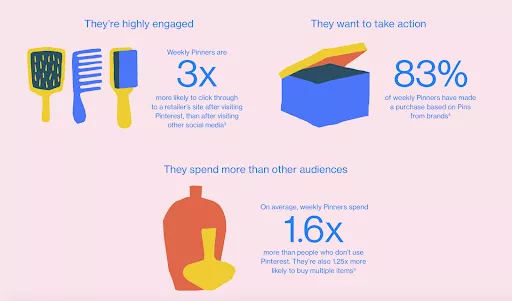
As for advertising, Pinterest is a hot spot for brands.
In 2020, Pinterest generated $706 million in advertising revenue, as per Statitista.
And even before the holidays of 2021 hit, that figure was at $633 million — bound to surpass 2020’s ad spend.
As you can see, there’s plenty of opportunity on Pinterest. But there’s also a lot of competition. So that’s why you need to learn about some of the best practices.
Ready to start winning with your e-commerce business’s marketing strategy? Let’s start off with the first best practice for Pinterest.
E-commerce Best Practices for Pinterest #1: Buy Followers
Look, like every other social media platform, Pinterest is destined for growth.
As Pinterest becomes more popular, it’ll be harder to gain new Pinterest followers organically.
And it also doesn’t help that just 32% of Pinterest users follow brands, according to Statista.
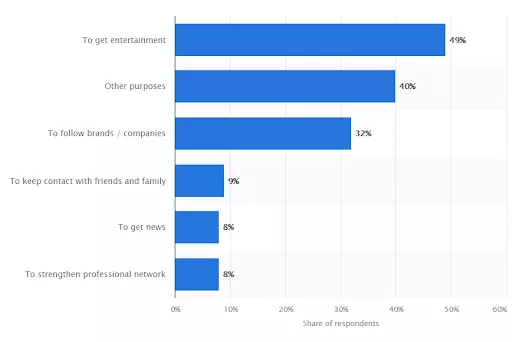
But by buying Pinterest followers , you’ll be able to attract even more followers much more quickly, thus increasing your Pinterest reach.
That’s because your brand will build more social proof.
And yes, it’s kind of like cheating.
But, let’s face it. No one wants to follow an account with 7 followers.
If you’re interested in buying Pinterest followers, you can use credible platforms like SidesMedia or Followersup.
E-commerce Best Practices for Pinterest #2: Use Rich Pins
Rich Pins allow you to attach extra information to your images that show up in Pinterest’s search results.
As a key benefit of this Pinterest best practice, a Rich Pin automatically syncs each time you update your website.
One thing that seems small but is actually important is the added boldness of your pin title.
With a bolded title, the pin sticks out more and just looks more professional.
To see what I mean, compare the Rich Pin with the normal Pin below.
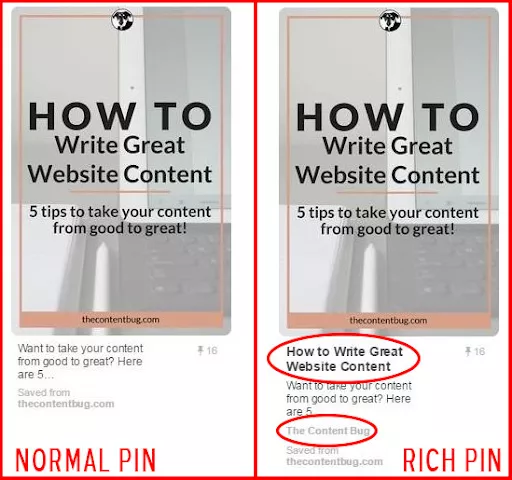
As for the types of Rich Pins you can use, there are:
- Product Rich Pins to show real-time status of inventory, pricing and other purchasing information.
- App Rich Pins for users to download an app directly from the Pin.
- Article Rich Pins so users see the author’s name, story description and headline for your blog post.
- Place Rich Pins which includes a photo, map and sometimes an address for users to see (good for travel industries).
- Movie Rich Pins for websites that promote or discuss film, including reviews, directors and actors.
In general, Rich Pins make the user experience a lot easier.
And when your Pins contain more information, users will be more likely to click on it.
According to Buffer, they saw a 100% increase in clicks by using Rich Pins for its blog promotion.
E-commerce Best Practices for Pinterest #3: Make Your Content Visually Appealing
It’s no secret that Pinterest is an image-first platform.
But Pinterest users need to see what your e-commerce products look like. Or they might want to see a header image for your blog article.
Don’t skimp out on the details. Making visual content highly appealing should be a top priority.
As found by Pinterest Newsroom, 80% of Pinners start their shopping journey with a visual search. That’s compared to 58% of non-Pinners.
Olay is a good example of an ec-ommerce brand excelling with visual content on Pinterest.
And it’s no wonder its profile has 6.5 million monthly views.
Each of its Pins are tailor-made for a visual-oriented audience.
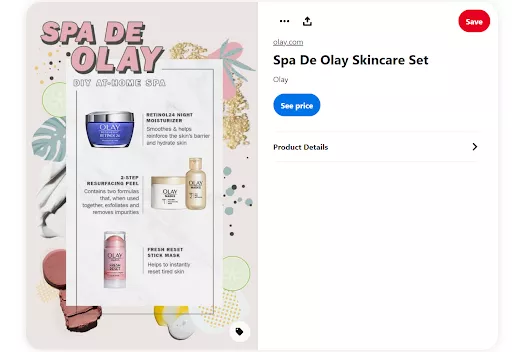
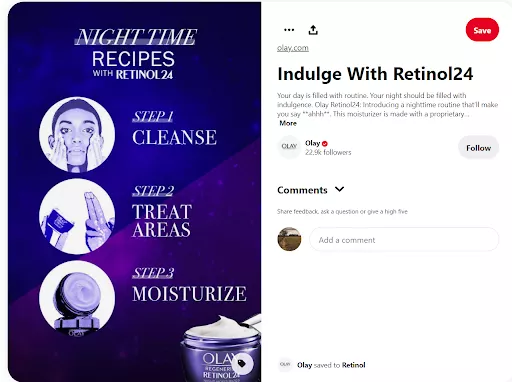
E-commerce Best Practices for Pinterest #4: Utilize Video
Although not everyone associates Pinterests with video, it’s actually incredibly popular.
According to Pinterest Business, over 1 billion videos are watched every day on their site.
And as reported by Pinterest, users are 55% more likely to make a purchase after seeing a video compared to other platforms.
So if you want to satisfy Pinners, you’ll need to upload video content from time to time.
But make sure to keep your videos short. Pinterest recommends between 15 seconds and 1 minute for organic content and 6-15 seconds for video ads.
E-commerce Best Practices for Pinterest #5: Add Pin Saves to Your Website
If you’ve read our article, “The 11 Laws of Sales Funnel Physics,” then you know about the Law of Friction —- make it as easy as possible for consumers to take your desired action.
For Pinterest best practices, this means making it easy for more people to save your content.
And one way to do that is by adding a Pinterest widget to your website. That way, your website visitors can save your content to their Pinterest account with a simple click.
As an example of the end result, check out the bottom of the below screenshot from Pottery Barn.
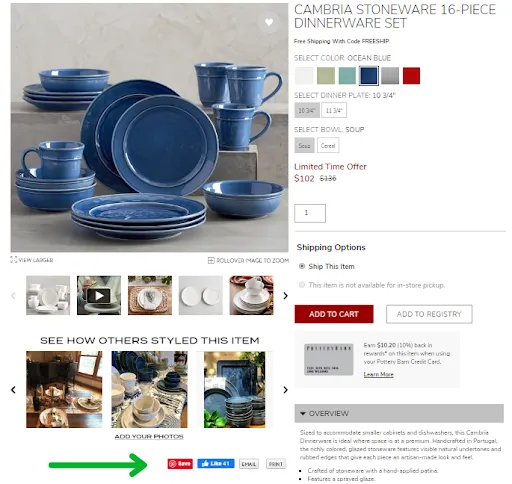
E-commerce Best Practices for Pinterest #6: Use Pinterest QR Codes
Like any QR code, Pinterest’s “Pincodes” allow customers to effortlessly access whatever you’re trying to promote via a simple scan.
Commonly, they’re included with a purchase that a customer has placed.
You can use Pincodes when a new customer makes a purchase from your e-commerce store. From there, include a Pincode that directs them back to product pages that you think they’d also be interested in based on their past purchases.
Not only does this help you promote your Pinterest account, it’ll lead to more e-commerce sales too.
If your products are sold in brick-and-mortar stores, Pincodes can be embedded on your product packaging so customers can learn more about your recipes or some discounts you’re offering.
For example, Nordstrom uses Pincodes in its stores to promote gifts under $100.
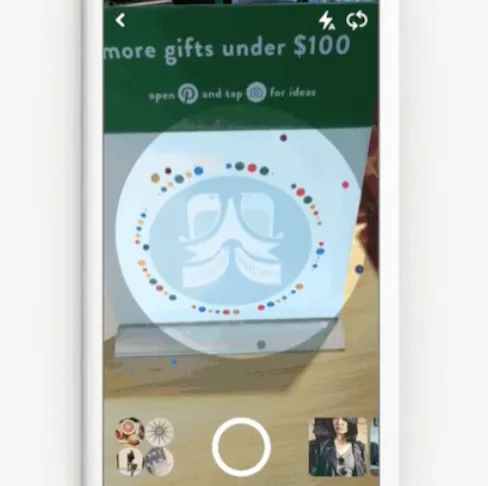
E-commerce Best Practices for Pinterest #7: Cater to Moms
It’s no secret that Pinterest is a little more geared toward the female demographic.
But did you know that 4 in 5 moms in the U.S. are actively using Pinterest? That’s according to Pinterest’s advertising guide.
So if you’re using a Pinterest business account, make sure you don’t forget about promoting your products or services in a way that resonates with moms.
For example, if you sell pet products, you could create an infographic that explains how to balance motherhood and taking care of your dog.
Just try to put a spin on things that target moms once in a while .
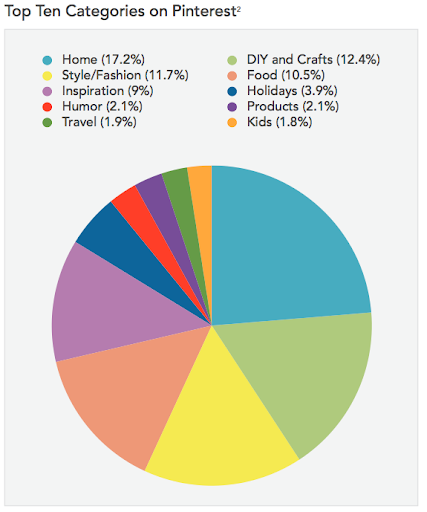
E-commerce Best Practices for Pinterest #8: Host a Contest
Who doesn’t like a good, old contest?
Deep down, it’s all about that competitive nature that humans possess.
And contests are a best practice for Pinterest because of the results they generate.
First, you create excitement for your brand.
Moreover, contests can grow your Pinterest followers, likes and repins, as more eyes are on your e-commerce business.
Basically, you’re giving users an incentive to join your brand ecosystem.
Don’t believe in the hype?
How about a case study?
Cosmetic e-commerce brand Beauty Bridge introduced its “Spooky Beauty” Halloween contest on Pinterest to actively engage with more customers.
For this, users were asked to create custom boards of their best Halloween costumes using Beauty Bridge’s product Pins and pictures of apparel, hairstyles and makeup.
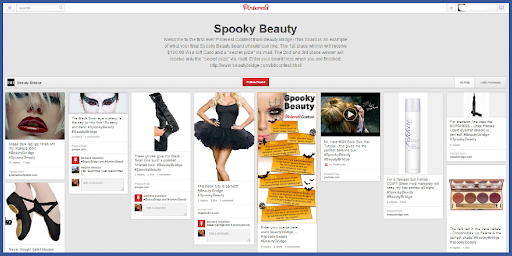
As a result of the Pinterest contest, Beauty Bridge doubled its Pinterest followers.
Not only that, they saw:
- 59.6% increase in referral traffic from Pinterest
- 198% more unique pageviews
- 86.8% increase in average pages visited per website visit
E-commerce Best Practices for Pinterest #9: Track Your Metrics and Audience Insights
Like other social media platforms, Pinterest allows business accounts to track metrics.
To do this, use the following directions:
- Log into your Pinterest business account.
- Click “Created” below your profile name.
- Click on a Pin to view your Pin stats. At the top-right of the screen, you’ll see some metrics for your Pin.
- Click “See more stats” to see all metrics for your Pin.
It’s easy to wing your Pinterest marketing strategy and base your performance on new e-commerce sales or likes.
But that’s not going to help you.
Without tracking metrics, how will you know where you can improve? Or what type of content is the best?
Tracking your metrics is the only way you’ll be able to gauge success and failure — so you can make more informed decisions.
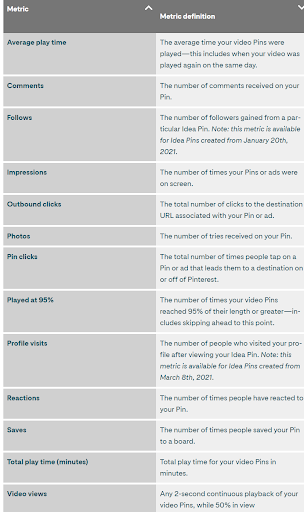
So tracking your metrics is step one.
But another best practice for Pinterest is to check on your Audience Insights.
To do so, follow these steps:
- Log into your Pinterest business account or go to your analytics page.
- Click “Analytics” at the top of the screen.
- Select “Audience Insights.”
Under Audience Insights, you can create affinities — so you can compare the interests of your audience with the average Pinterest user. That way, you understand more about what content your audience is likely to engage with.
And you can also check the demographics of your audience, such as age, gender, location and device.
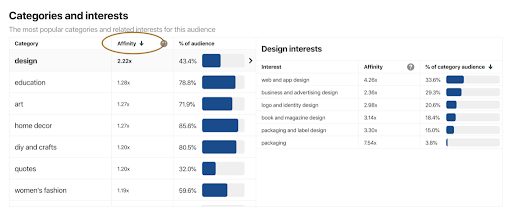
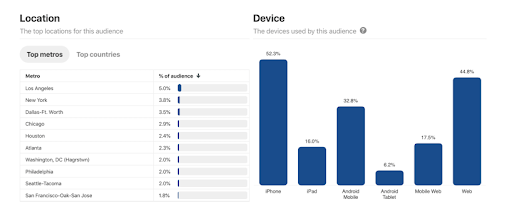
E-commerce Best Practices for Pinterest #10: Target Specific Keywords
The key to SEO success on Pinterest is to use narrowed-down long-tail keywords.
For best practice, find niches that users are interested in.
Pinners normally don’t include brand names in their search queries . As stated by Pinterest, 97% of the top searches are non-branded.
So that means there’s always great opportunities to make your brand known to newcomers.
Just as long as you choose the right keywords.
And finding the right keywords is not that difficult.
You can use the auto-suggest search bar to show you popular topics in your industry.
Below is an example of when I typed in “interior design” into the search bar.

By seeing the trending topics, it provides a good basis for your content strategy.
When you decide on your keywords, you can incorporate them into your ads, hashtags, board descriptions, Pin captions, images from your website, profile, and anywhere else SEO can be affected.
E-commerce Best Practices for Pinterest #11: Include Product Tags
Pinners love seeing products placed in a scene.
Because it gives them a good sense for what it might look like in a natural setting.
For example, a photo of a woman wearing a dress and a jacket outside.
But what’s even better is if you add product tags for your Pins.
According to Pinterest Newsroom, Pinners are 70% more likely to show shopping interest on e-commerce products tagged in scene images than with normal Product Pins.
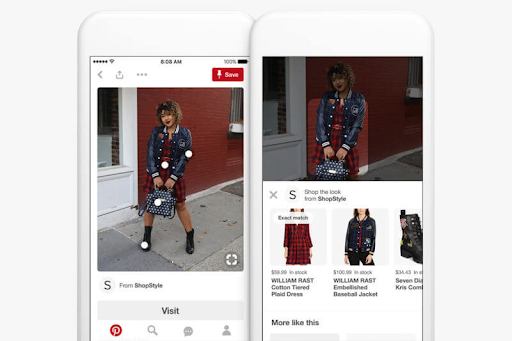
And it isn’t rocket science. Product tags make for a convenient shopping experience.
Instead of having to take note of the brand and product name, then search for it in the web browser, a consumer can simply click on the tagged product and be directed to the product page.
At the end of the day, consumers look for the easiest buying solutions.
E-commerce Best Practices for Pinterest #12: Prepare for the Holidays Early
Pinterest is a popular platform during the holiday season when users are searching for gifts.
But that shopping experience starts earlier than you may think.
For best practice, Pinterest recommends e-commmerce businesses start their holiday marketing campaigns 30 to 45 days early.
According to Pinterest Business, brands that advertise early see 6% more sales.
And conversions are 4.7 times higher when shoppers are exposed to Pinterest ads early.
E-commerce Best Practices for Pinterest #13: Make Sure To Have the Right Image Sizes
The last best practice for Pinterest is to make sure you use the right image size.
Remember, Pins are organized into columns, so verticality is your friend. So you want your Pins to be taller than they are wide.
A 2 to 3 aspect ratio is optimal for Pinterest images. And at minimum, 600 pixels wide by 900 pixels tall. For square Pins, 600 by 600 is fine.
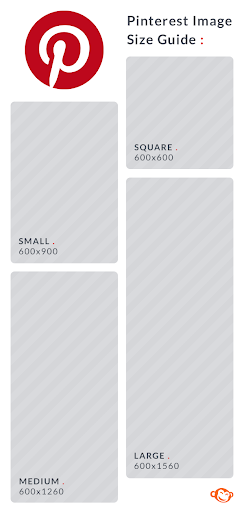
And taller Pins are more popular too.
In a study from HubSpot, it was found that taller images receive more Repins.
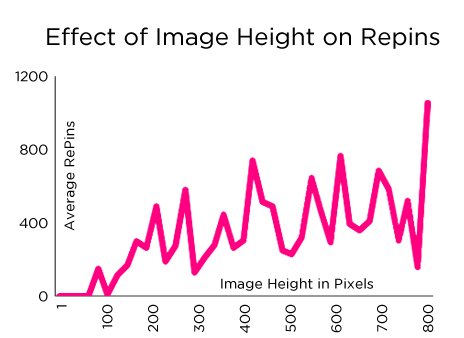
Conclusion
Want to delegate all your marketing and funnel work done—without the headaches of hiring? Download our free guide: 33 Marketing Projects You Can Delegate to Growbo and discover how to save 100+ hours a month, grow faster, and scale without the overhead.
There you have it.
The 13 E-commerce Best Practices for Pinterest in this article should provide you with a good starting point for getting started on the platform.
From using product tags to tracking your metrics and everything in between, I hope this resource helps to make your next campaign get you results that you haven’t seen before.
And keep an eye on the Growbo articles page as we publish some more Pinterest posts.
But if you’re ready to step right into a Pinterest campaign and need some support, try us risk-free with a free trial.
Not a lot of marketing service providers offer trials like us. If you go to an agency, they usually want to get you on a call and provide a quote after assessing your marketing needs.
But we’re confident in our ability to maximize your potential. Our team of experts are ready and waiting to partner with you (and they know Pinterest like the back of their hand).
As always, thanks for reading.
And before you go ...
Which one of these Pinterest best practices do you like the most?
Let me know in the comments below.
Keep Growin’, stay focused.
Mark













